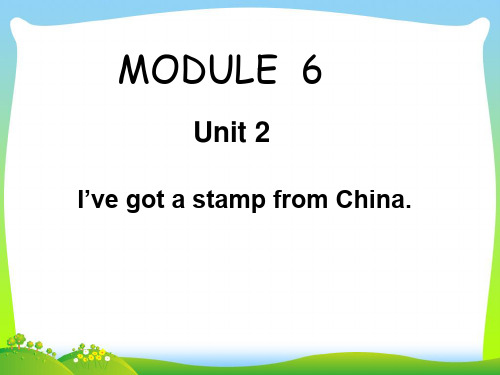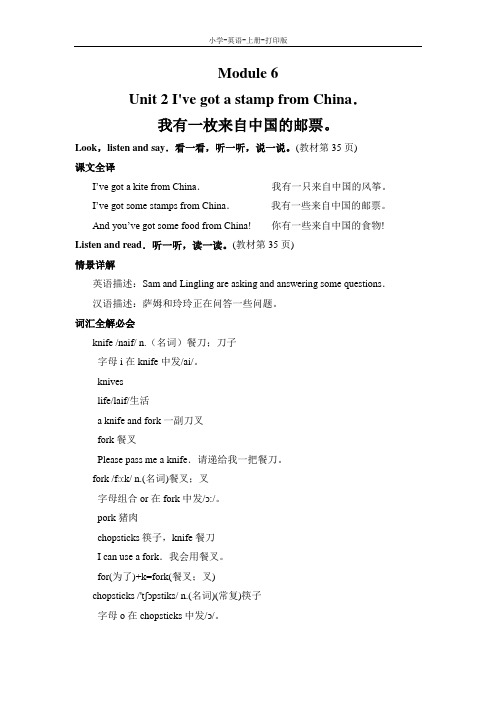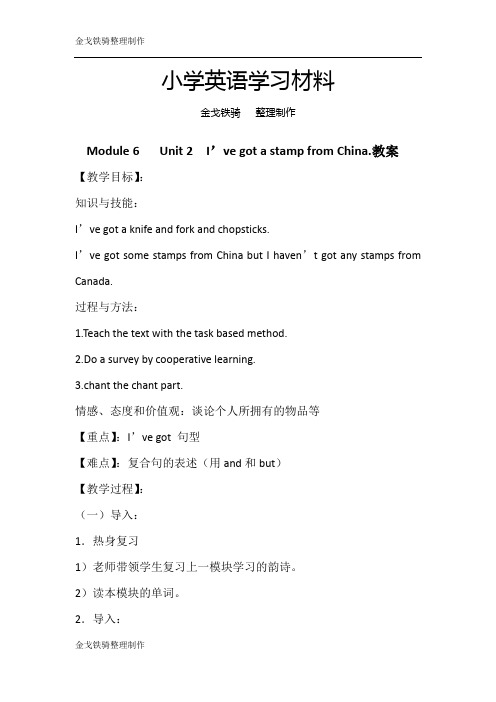MODULE_6Unit_2《_I`ve_got a stamp from_China》ppt课件
- 格式:ppt
- 大小:786.50 KB
- 文档页数:23

Module 6 Unit 2 I’ve got a stamp from China (教案)教学内容:本课选自人教版小学英语六年级上册,Module 6 Unit 2 I’ve got a stamp from China。
本节课主要学习描述物品来自哪里,以及如何表达对物品的喜爱。
教学内容包括词汇、句型、语法和听力练习。
教学目标:1. 知识与技能:学生能够理解并运用句型“I’ve got a…from…”描述物品的来源,并能够表达对物品的喜爱。
2. 过程与方法:通过小组合作、情境创设和任务驱动,培养学生运用英语进行交流和解决问题的能力。
3. 情感态度与价值观:激发学生对英语学习的兴趣,提高跨文化交际意识,培养学生热爱生活、热爱集邮的情感。
教学难点:1. 正确运用句型“I’ve got a…from…”描述物品的来源。
2. 听懂并准确描述他人的邮票来源。
3. 理解并运用词汇stamp, collection, hobby, exchange等。
教具学具准备:1. 教师准备PPT、教学录音、邮票图片等。
2. 学生准备邮票、笔记本、彩笔等。
教学过程:1. 导入a. 教师出示一张邮票,引导学生关注邮票的来源和特点。
b. 学生分享自己收集的邮票,用中文描述邮票的来源和喜爱之情。
2. 新课展示a. 教师播放录音,学生跟读并学习新词汇。
b. 教师创设情境,引导学生运用句型“I’ve got a…from…”描述物品的来源。
c. 学生分小组讨论,用所学句型描述自己收集的邮票。
3. 练习巩固a. 教师出示一张邮票,学生用所学句型描述其来源。
b. 学生听录音,完成听力练习。
c. 学生分小组,用所学句型进行角色扮演。
4. 课堂小结a. 教师引导学生总结本节课所学内容。
b. 学生分享学习收获,用英语表达对邮票的喜爱。
板书设计:Module 6 Unit 2 I’ve got a stamp from ChinaI’ve got a stamp from China.I’ve got a coin from America.I’ve got a postcard from Australia.…作业设计:1. 完成课本P55练习题1、2、3。

六年级上册英语教案Module 6 Unit 2 I’ ve got a stampfrom China. 外研三起教学内容1. 词汇:stamp, from, China, postcard, Australia, Japan, Russia, New York, London, Canada2. 句型:I’ve got a stamp from3. 语法:现在完成时态的运用教学目标1. 知识与技能:学生能够听懂、会说、会读本节课的重点词汇和句型,并能运用现在完成时态描述自己拥有的邮票或明信片。
2. 过程与方法:通过小组合作、角色扮演等活动,培养学生合作学习的能力和英语口语表达能力。
3. 情感态度价值观:激发学生对集邮的兴趣,培养学生对多元文化的尊重和欣赏。
教学难点1. 现在完成时态的运用2. 词汇的发音和记忆3. 句型的灵活运用教具学具准备1. 教学课件2. 邮票和明信片实物或图片3. 学生课本4. 黑板和粉笔1. 导入:通过展示一些邮票和明信片的图片,引起学生的兴趣,然后引导学生谈论自己是否喜欢集邮,以及他们所知道的关于邮票的知识。
2. 新课内容呈现:通过教学课件呈现本节课的重点词汇和句型,让学生跟读并模仿发音,然后进行一些练习活动,如填空、选择等,帮助学生巩固所学知识。
3. 小组活动:将学生分成小组,给每个小组一些邮票和明信片,让他们用所学句型进行交流和描述,然后进行汇报展示。
4. 角色扮演:让学生扮演邮票收藏家,用所学句型进行交流,描述自己拥有的邮票,并询问对方是否有相同的邮票。
板书设计Module 6 Unit 2 I’ ve got a stamp from China.重点词汇:stamp, from, China, postcard, Australia, Japan, Russia, New York, London, Canada句型:I’ve got a stamp from语法:现在完成时态的运用作业设计1. 完成课本练习题2. 写一篇关于自己拥有的邮票的短文3. 设计一张邮票,并用所学句型进行描述课后反思重点关注的细节是“教学难点”的攻克和“教学过程”的设计与实施。

六年级上册英语-Module 6 Unit 2 I’ve got a stamp fromChina.外研版(三起)本篇文章主要介绍的是六年级上册英语外研版-Module 6 Unit 2的内容。
这个单元主要介绍了收集邮票这一主题,孩子们通过学习,可以更好地了解到收集邮票的乐趣与意义。
课文内容这个单元的主题是“我有一张来自中国的邮票”,主要是讲述了孩子们在收集邮票中的经历。
教材中介绍了邮票的样子以及来自不同国家的邮票,同时还介绍了邮票的主题,其中不乏动物、名人、音乐等。
在学习邮票的同时,孩子们还可以通过这个单元学习一些国家的发展历程和文化习俗。
在教材中还有一些与邮票收藏相关的词汇,例如邮局、邮递员等。
学习目标通过本单元的学习,学生可以:1.学习和了解邮票收藏的乐趣和意义;2.学习识别不同的邮票和邮票的来源国家;3.学习邮票的主题,以及不同的发展历程和文化习俗;4.通过学习与邮票收藏相关的词汇,增加词汇量。
练习内容在学习了本单元的内容之后,教材中还有一些练习题,帮助学生更好地掌握所学知识。
这些练习题包括选出正确的词语组合、填写单词、说出来自不同国家的邮票等等。
通过这些练习,学生可以巩固所学的知识,并且提高英语的听、说、读、写的能力。
词汇表以下是本单元中出现的一些词汇:•stamp:邮票•collect:收集•post office:邮局•postage stamp:邮票•envelope:信封•letter:信件•mail:邮寄•air mail:航空邮件•postcard:明信片总结在学习了本单元的内容之后,学生可以更好地了解到邮票收藏的乐趣与意义,同时也了解了一些国家的发展历程和文化习俗。
通过学习与邮票收藏相关的词汇,可能还会增加学生的词汇量。
学生通过解答教材中的练习题,可以巩固所学的知识,并提高英语的听、说、读、写能力。


Module 6Unit 2 I've got a stamp from China.我有一枚来自中国的邮票。
Look,listen and say.看一看,听一听,说一说。
(教材第35页)课文全译I’ve got a kite from China.我有一只来自中国的风筝。
I’ve got some stamps from China.我有一些来自中国的邮票。
And you’ve got some food from China! 你有一些来自中国的食物! Listen and read.听一听,读一读。
(教材第35页)情景详解英语描述:Sam and Lingling are asking and answering some questions.汉语描述:萨姆和玲玲正在问答一些问题。
词汇全解必会knife /naif/ n.(名词)餐刀;刀子字母i在knife中发/ai/。
kniveslife/laif/生活a knife and fork一副刀叉fork餐叉Please pass me a knife.请递给我一把餐刀。
fork /fɔ:k/ n.(名词)餐叉;叉字母组合or在fork中发/ɔ:/。
pork猪肉chopsticks筷子,knife餐刀I can use a fork.我会用餐叉。
for(为了)+k=fork(餐叉;叉)chopsticks /'tʃɔpstiks/ n.(名词)(常复)筷子字母o在chopsticks中发/ɔ/。
a pair of chopsticks一双筷子fork餐叉,spoon勺子,bowl碗,knife餐刀,plate盘子Do you use chopsticks in England?你们在英国使用筷子吗? Japanese /͵dʒæpə'ni:z/ adj.(形容词)日本的Japanese日语Japan/dʒə'pæn/日本I don’t like eating Japanese food.我不喜欢吃日本的食物。

小学英语学习材料金戈铁骑整理制作Module 6 Unit 2 I’ve got a stamp from China.教案【教学目标】:知识与技能:I’ve got a knife and fork and chopsticks.I’ve got some stamps from China but I haven’t got any stamps from Canada.过程与方法:1.Teach the text with the task based method.2.Do a survey by cooperative learning.3.chant the chant part.情感、态度和价值观:谈论个人所拥有的物品等【重点】:I’ve got 句型【难点】:复合句的表述(用and和but)【教学过程】:(一)导入:1.热身复习1)老师带领学生复习上一模块学习的韵诗。
2)读本模块的单词。
2.导入:请一名学生提前做好准备,扮成一位魔术师,从各个地方变出不同的东西。
要求这名学生一边变魔术—边说:“I have got a…?”然后老师向几位学生提问:“What has he got?”要求学生如实回答。
3. 活动一:课前发给每位学生一张空白表格,但必须限制其中所填内容的种类。
学生可选择画出或写出单词。
如:邮票,餐具,书籍,玩具,宠物,颜色两人一组开展活动。
让生通过提问的方式去猜测别人所拥有的物品有哪些。
并完成下表。
画出或写出你同桌拥有的物品:运用句型:Have you got a knife and fork?Have you got a knife or a fork? …(二)探究新知:1.用挂图和录音呈现SB第二单元活动1的内容。
老师提出问题:Has the girl got a knife and fork or chopsticks ?Has the boy got a Chinese kite or a Japanese kite ?Has the girl got a book about America or a book about China ?Has the boy got stamps from China or stamps from Canada ?How do you know ?3. 再放录音,让学生看图听。
Module 6Unit 2 I’ve got a stamp from China. Teaching contentNSE(三年级起点Grade 6 第7册Module 6 Unit 2) Teaching aims1.Be able to master words:knife fork chopsticks Japanese2.Learn to use:—Have you got … or …?—I’ve got … and …. .I’ve got … , but I haven’t got … . Teaching Key pointTalk about somebody’s got.Teaching methodsThe first post- teaching , get training in class.Teaching aidsThe multi-media, radio, picturesTeaching processStep I Warming-up & Lead-in1. Greetings.2.Sing a song. ( I have a table in my little badroom…)3 .Show Self-learning tips.Step II Presentation1. Show a stamp from China to the students.T : What’s it ?Ss : It’s a stamp.T : a stamp…( point to the Chinese words “中国” )Ss : a stamp from China.T : Look, a stamp from China.So I can say: I’ve got a stamp from China.( Boarding )Read after the teacher, then read in groups.2. Show a stamp from Canada to the students.Learn the sentence: “ Have you got … or …? ”T : Listen carefully,“ Have you got a stamp from China or a stamp from Canada ? ”( Boarding )3. Learn the two sentences based on the check marks.I’ve got … and …. .I’ve got … , but I haven’t got … .( Boarding )4. learn new wordsSelf-learn the new words in groups.a knife and fork chopsticks a Japanese kite5. Play a game.Practice the key senences by playing this gussing game.6. Let’s chant.7. Learn the dialogue.(1) Watch the video, then answer the questions .(2) Read the dialogue after the video.(3) Read after the teacher.Step III Practice1. Read the dialogue in pairs.1.Show time. ( Work in pairs and act the dialogue out. )Step IV Consolidation1. Talk about your things or the things in the classroom in groups.2. Come to the platform and show your dialogue with your partners. Step V Homework1. Read the dialogue after class.2. Practise the dialogue in pairs.Step VI Boarding designUnit 2 I’ve got a stamp from China.—Have you got a or ?—I’ve got … and …. .I’ve got … , but I haven’t got … .。
Module 6 Unit 2 I've got a stamp from China教学设计一、教材分析:本节课是外研版(三起)小学英语六年级上册的第六模块的第二单元,主要围绕"邮票"这个话题展开。
通过本单元的学习,学生将学习如何描述自己拥有的邮票,并了解不同国家的邮票。
教材中包含了听说读写的综合训练,培养学生的听说能力和语言表达能力。
二、教学目标:1. 听:能听懂老师和同学对邮票的描述,并获取相关信息。
2. 说:能用简单的句子描述自己拥有的邮票,并能就邮票的国家、图案等进行简单交流。
3. 读:能读懂与邮票相关的简短对话和句子。
4. 写:能写出简单的句子描述自己拥有的邮票。
三、教学重点和教学难点:教学重点:培养学生的听说读写能力,学会描述自己拥有的邮票。
教学难点:学生能够用简单的句子进行口头和书面表达。
四、学情分析:学生是小学六年级的学生,已经具备了一定的英语基础,能够进行简单的英语交流。
他们对于认识不同国家的文化和事物有一定的兴趣。
然而,他们的词汇量较为有限,口语表达能力相对较弱。
因此,在教学过程中需要注重培养学生的听说能力和语言表达能力。
五、教学过程:Step 1: Warm-up- Greet the students and review the previous lesson briefly.-Show some pictures of stamps from different countries and ask the students if they know what they are.- Teacher: "What are these? Have you seen them before?"- Students: "They are stamps!"-Teacher: "That's right! Today, we are going to talk about stamps. Have you ever seen or collected stamps before?"Step 2: Presentation- Present new vocabulary using flashcards or visual aids: stamp, country, picture, collector.-Teacher: "This is a stamp. It's a small piece of paper with a special design on it. It usually comes from a different country. The design on the stamp is called a picture. People who collect stamps are called collectors."-Show real stamps or pictures of stamps to introduce the concept of stamps and their different designs.- Teacher: "Look at this stamp from China. It has a picture of the Great Wall. Can you see it?"- Allow students to observe and discuss the different stamps. Step 3: Practice- Divide the students into pairs or small groups.- Have them take turns asking and answering questions about their stamps using the target language.- Student A: "Have you got any stamps?"- Student B: "Yes, I've got a stamp from China. It has a picture of the Great Wall."-Student A: "That's interesting! What other stamps have you got?"-Circulate around the classroom, providing assistance and feedback as needed.- Encourage students to ask follow-up questions to gather more information about their classmates' stamps.- Teacher: "Now, let's practice in pairs. Ask your partner about their stamps and share information with each other."Step 4: Listening and Speaking- Play an audio recording of a conversation about stamps.-Teacher: "Listen to this conversation about stamps. Pay attention to the questions and answers."- Play the recording once.-Teacher: "Now, answer these questions based on the conversation."-Ask comprehension questions about the conversation and have students answer individually or in pairs.-Play the recording again and have the students repeat the sentences to practice their pronunciation.-Pair the students and have them role-play the conversation using their own stamps.-Teacher: "Now, work with a partner and role-play the conversation using the information about your stamps."Step 5: Reading and Writing- Distribute worksheets with short passages about stamps from different countries.-Teacher: "Read the passages silently and answer the questions."-Students read the passages and answer comprehension questions individually.- Ask a few students to share their answers with the class.- Teacher: "Now, imagine you could have any stamp you want.Write a short paragraph describing the stamp you would like to have. Include the country and the picture on it."-Students write a short paragraph describing their desired stamp.-Monitor the students' writing and provide assistance as needed.Step 6: Wrap-up- Review the key vocabulary and phrases learned in the lesson. - Teacher: "Let's review the vocabulary we learned today. Who can tell me what a stamp is?"- Call on different students to provide the definitions.- Ask some students to share their descriptions of the stamps they would like to have.-Teacher: "Now, let's hear from a few students. What stamp would you like to have and why?"六、板书设计:Unit 2 I've got a stamp from China.Vocabulary: stamp, country, picture, collectorKey Sentences:- Have you got any stamps?- Yes, I've got a stamp from China. It has a picture of the GreatWall.七、教学反思:在本节课的教学过程中,学生通过多种形式的教学活动,如图片展示、对话模仿、听力练习、阅读写作等,积极参与了课堂活动。